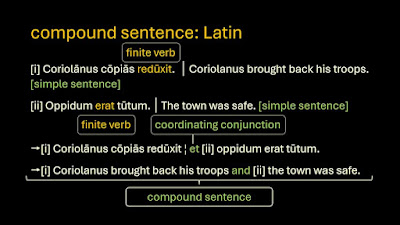10.07.24: Level 2:
Sentence structure [1]; terminology (1)
[i] sentence: simple sentence; compound sentence
[ii] verb: finite verb
[iii]
conjunction: coordinating conjunction
[iv] clause: main / principal clause
simple and compound
sentences
Image #1
[i] simple sentence:
John goes to the shops every day.
The sentence stands
alone and makes sense.
It contains
one finite verb, a verb that has [a] a subject [b] number and
[c] a tense.
Rōmānī nūntiōs ad
Cincinnātum mīsērunt. │ The Romans sent messengers
to Cincinnatus.
Image #2:
[ii] compound sentence.
John goes to
the shops every day. He buys bread.
Two simple
sentences. Both have a single finite verb and both can stand alone and make
sense. Now join them:
[1] John goes to
the shops every day and [2] (he) buys bread.
A compound sentence
comprises two or more simple sentences joined by a coordinating
conjunction e.g. ‘and’ or ‘but’.
[1] Coriolānus
cōpiās redūxit. │ Coriolanus brought back his troops. [simple sentence]
[2] Oppidum erat
tūtum. │ The town was safe. [simple sentence]
[1] Coriolānus
cōpiās redūxit [finite verb] ¦ et [2]
oppidum erat [finite verb] tūtum. │ Coriolanus brought back
his troops andthe town was safe. [compound sentence]
Image #3: However,
now that the two separate sentences are joined to form one sentence, those
original sentences are described as clauses i.e. those
“blocks” of information mentioned at the beginning of the post. This is where a
range of different terms can be used.
The clauses here
are called principal or main clauses because
they both originally could stand alone. A principal clause is the main idea in
a sentence.



No comments:
Post a Comment